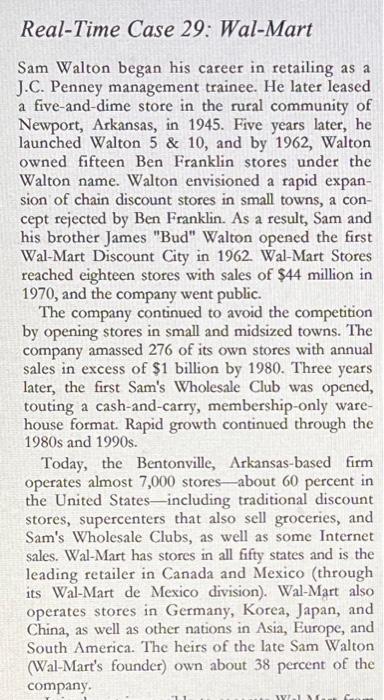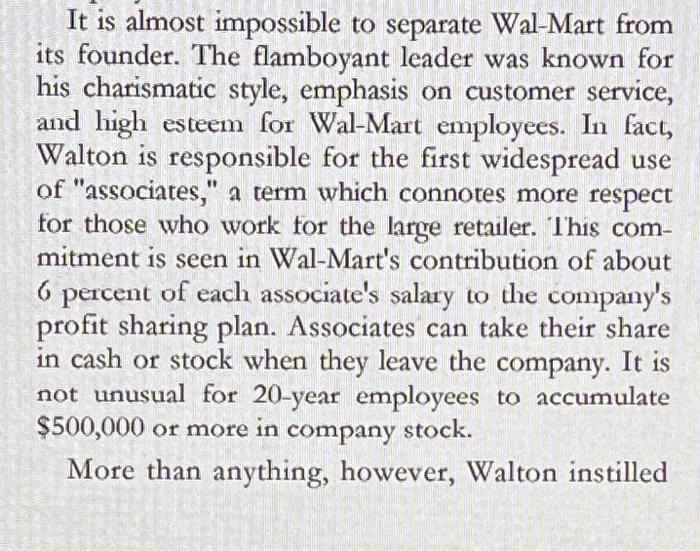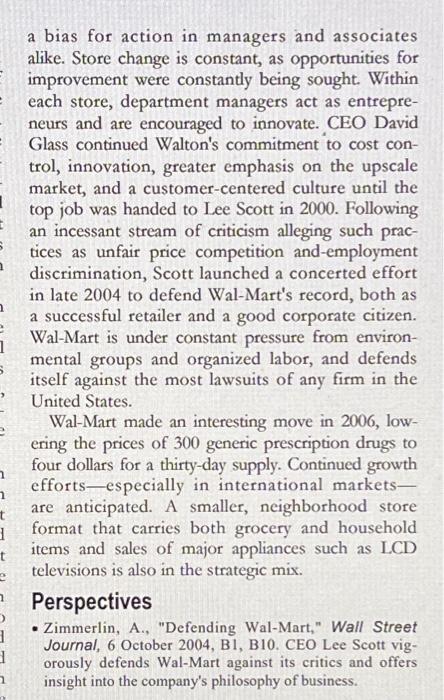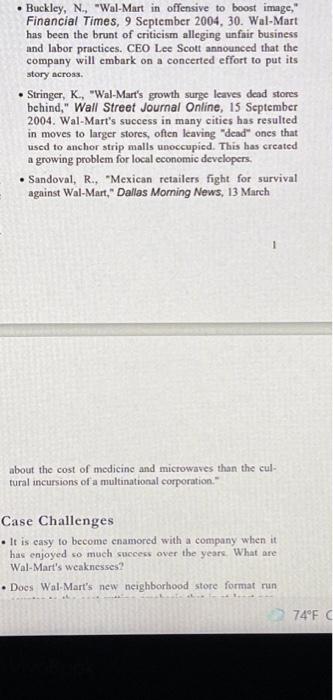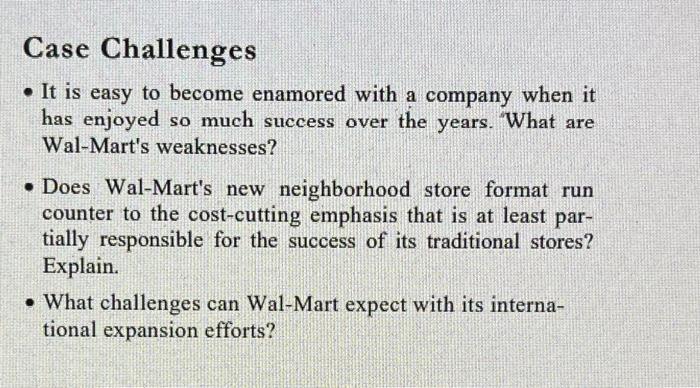Real-Time Case 29: Wal-Mart Sam Walton began his career in retailing as a J.C. Penney management trainee. He later leased a five-and-dime store in the rural community of Newport, Arkansas, in 1945. Five years later, he launched Walton 5 & 10, and by 1962, Walton owned fifteen Ben Franklin stores under the Walton name. Walton envisioned a rapid expan- sion of chain discount stores in small towns, a con- cept rejected by Ben Franklin. As a result, Sam and his brother James "Bud" Walton opened the first Wal-Mart Discount City in 1962 Wal-Mart Stores reached eighteen stores with sales of $44 million in 1970, and the company went public. The company continued to avoid the competition by opening stores in small and midsized towns. The company amassed 276 of its own stores with annual sales in excess of $1 billion by 1980. Three years later, the first Sam's Wholesale Club was opened, touting a cash-and-carry, membership-only ware- house format. Rapid growth continued through the 1980s and 1990s. Today, the Bentonville, Arkansas-based firm operates almost 7,000 stores-about 60 percent in the United Statesincluding traditional discount stores, supercenters that also sell groceries, and Sam's Wholesale Clubs, as well as some Internet sales. Wal-Mart has stores in all fifty states and is the leading retailer in Canada and Mexico (through its Wal-Mart de Mexico division). Wal-Mart also operates stores in Germany, Korea, Japan, and China, as well as other nations in Asia, Europe, and South America. The heirs of the late Sam Walton (Wal-Mart's founder) own about 38 percent of the company YY It is almost impossible to separate Wal-Mart from its founder. The flamboyant leader was known for his charismatic style, emphasis on customer service, and ligh esteem for Wal-Mart employees. In fact, Walton is responsible for the first widespread use of "associates," a term which connotes more respect for those who work for the large retailer. This com- mitment is seen in Wal-Mart's contribution of about 6 percent of each associate's salary to the company's profit sharing plan. Associates can take their share in cash or stock when they leave the company. It is not unusual for 20-year employees to accumulate $500,000 or more in company stock. More than anything, however, Walton instilled - 1 1 1 a bias for action in managers and associates alike. Store change is constant, as opportunities for improvement were constantly being sought. Within each store, department managers act as entrepre- neurs and are encouraged to innovate. CEO David Glass continued Walton's commitment to cost con- trol, innovation, greater emphasis on the upscale market, and a customer-centered culture until the top job was handed to Lee Scott in 2000. Following an incessant stream of criticism alleging such prac- tices as unfair price competition and employment discrimination, Scott launched a concerted effort in late 2004 to defend Wal-Mart's record, both as a successful retailer and a good corporate citizen. Wal-Mart is under constant pressure from environ- mental groups and organized labor, and defends itself against the most lawsuits of any firm in the United States. Wal-Mart made an interesting move in 2006, low- ering the prices of 300 generic prescription drugs to four dollars for a thirty-day supply. Continued growth efforts-especially in international markets- are anticipated. A smaller, neighborhood store format that carries both grocery and household items and sales of major appliances such as LCD televisions is also in the strategic mix. Perspectives Zimmerlin, A., "Defending Wal-Mart," Wall Street Journal, 6 October 2004, B1, B10. CEO Lee Scott vig- orously defends Wal-Mart against its critics and offers insight into the company's philosophy of business. 7 t 11 t - 2 . . Buckley, N., "Wal-Mart in offensive to boost image." Financial Times, 9 September 2004, 30. Wal-Mart has been the brunt of criticism alleging unfair business and labor practices. CEO Lee Scott announced that the company will embark on a concerted effort to put its story across Stringer, K., "Wal-Mart's growth surge leaves dead stores behind," Wall Street Journal Online, 15 September 2004. Wal-Mart's success in many cities has resulted in moves to larger stores, often leaving "dead" ones that used to anchor strip malls unoccupied. This has created a growing problem for local economic developers. Sandoval, R., "Mexican retailers fight for survival against Wal-Mart," Dallas Morning News, 13 March about the cost of medicine and microwaves than the cul tural incursions of a multinational corporation." Case Challenges . It is easy to become enamored with a company when it has enjoyed so much success over the years. What are Wal-Mart's weaknesses? Does Wal-Mart's new neighborhood store format run 74F C Case Challenges It is easy to become enamored with a company when it has enjoyed so much success over the years. What are Wal-Mart's weaknesses? Does Wal-Mart's new neighborhood store format run counter to the cost-cutting emphasis that is at least par- tially responsible for the success of its traditional stores? Explain. What challenges can Wal-Mart expect with its interna- tional expansion efforts
